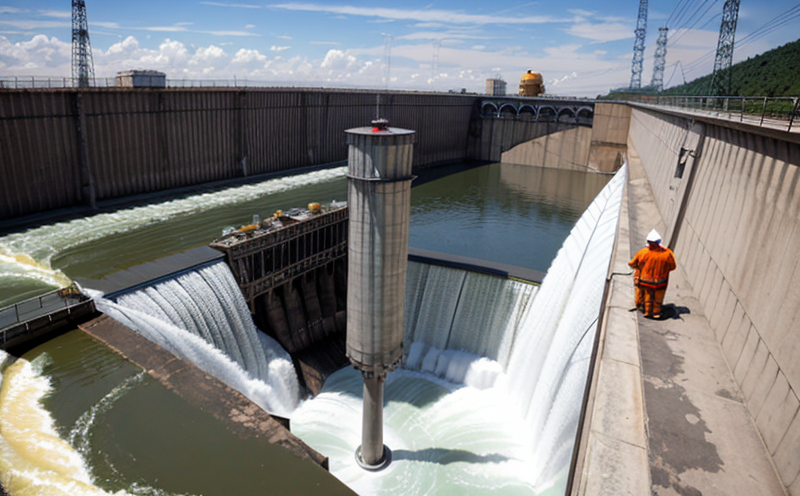Hydroelectric turbine inspection
The inspection of hydroelectric turbines is critical to ensure optimal performance and longevity. Hydroelectric turbines are complex mechanical systems that generate electricity by converting the energy in flowing water into rotational energy, which drives a generator.
Regular inspections help detect potential issues early on, preventing costly downtime and ensuring compliance with environmental regulations. The sector of Energy Systems and Environmental Surveillance focuses on monitoring and maintaining critical infrastructure like hydroelectric plants to ensure they operate safely and efficiently.
Hydroelectric turbines are made up of several key components including the runner, guide vanes, main shaft, generator, and control system. Each component plays a crucial role in the overall performance of the turbine. For instance, the runner converts the kinetic energy of water into mechanical energy, while the guide vanes direct water flow to maximize efficiency.
The inspection process is designed to evaluate these critical components for signs of wear, corrosion, or damage that could compromise safety and operational integrity. This includes visual inspections as well as more detailed non-destructive testing (NDT) methods such as ultrasonic testing, eddy current testing, and radiographic examination.
During the inspection, it is important to follow a structured methodology that adheres to international standards like ISO 9712 for welding codes or ASTM E348 for heat treating of stainless steel. These standards ensure consistency and reliability in the inspection process.
Scope and Methodology
| Component | Inspection Focus | Methodologies Used |
|---|---|---|
| Runner | Inspect for cracks and wear | Ultrasonic testing, eddy current testing |
| Guide Vanes | Evaluate for erosion and misalignment | Radiographic examination, visual inspection |
| Main Shaft | Check for corrosion and deformation | Magnetic particle testing, eddy current testing |
| Generator | Analyze insulation integrity and bearing wear | Infrared thermography, oil analysis |
| Component | Acceptance Criteria | Reporting |
|---|---|---|
| Runner | No visible cracks, no excessive wear beyond 10% of original dimensions | Detailed report with images and measurements |
| Guide Vanes | Even water flow distribution, no more than 5% erosion | Document alignment angles and wear patterns |
| Main Shaft | No cracks or deformation affecting rotation | Measurements of shaft straightness and roundness |
| Generator | Insulation resistance above 100 MΩ, no bearing wear beyond manufacturer specifications | Comprehensive report including test results and recommendations |
- ISO 9712: Non-destructive testing - Qualification and certification of personnel
- ASTM E348: Heat treating of stainless steel
- EN ISO 5817: Welding - Defects in fusion-welded joints of pressure equipment
Why Choose This Test
The inspection of hydroelectric turbines is essential for maintaining the safety and efficiency of power generation. Regular inspections can prevent catastrophic failures, which could lead to significant downtime and financial losses.
In addition to the direct benefits of avoiding failure, regular inspections also ensure compliance with environmental regulations. Proper maintenance of hydroelectric plants helps minimize ecological impact by preventing accidental releases of water or debris into surrounding ecosystems.
The inspection process is not only about identifying problems but also about understanding the root causes of issues. This knowledge can be used to improve design and manufacturing processes, leading to more robust turbines in future projects.
From a business perspective, early detection of potential issues allows for proactive maintenance strategies that are less costly than reactive repairs after failure occurs. Moreover, compliance with international standards such as ISO 9712 ensures consistency and reliability in the inspection process, which is crucial for maintaining good standing with regulatory bodies.
In summary, hydroelectric turbine inspections are a vital part of any comprehensive maintenance strategy aimed at ensuring safety, efficiency, and environmental responsibility. By choosing this test, stakeholders can contribute to safer operations while also supporting long-term sustainability goals.
International Acceptance and Recognition
- The International Electrotechnical Commission (IEC) recognizes the importance of hydroelectric turbine inspections in ensuring global safety standards.
- European Union directives like those under EN ISO 5817 emphasize the need for rigorous inspection processes to prevent accidents and ensure compliance with environmental laws.
- The North American Energy Standards Board (NASEB) supports regular inspections as a key component of plant maintenance programs.
- Australian regulatory bodies also require comprehensive inspections to meet stringent safety and environmental standards.
These international bodies underscore the significance of hydroelectric turbine inspections, ensuring they are widely accepted and recognized across different regions. Compliance with these standards not only enhances safety but also fosters trust among stakeholders and regulatory authorities worldwide.





